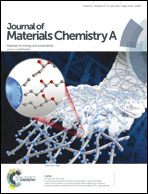Protected lithium anode with porous Al2O3 layer for lithium–sulfur battery†
Abstract
The performance of the metallic lithium anode is one of the major factors that affect the cycle stability of a lithium–sulfur battery. The protection of the lithium anode is extremely essential, especially for lithium–sulfur full-cells. Here, a porous Al2O3 layer is fabricated on the surface of a metallic lithium anode by using a spin-coating method as protective layer for a lithium–sulfur battery. The porous Al2O3 protective layer acts as a stable interlayer and suppresses the side reactions between soluble lithium polysulfides and lithium anode by direct contact during the charge–discharge process. In addition, the inhomogeneous dissolution–deposition reaction, and the formation of serious cracks on the protected lithium anode are suppressed to a certain extent, which is beneficial to ensure the good and stable electrochemical activity of the lithium anode. Correspondingly, the sulfur cathode with the protected lithium anode exhibits improved electrochemical performance, accompanied simultaneously with relatively homogeneous lithium deposition on the anode surface due to the even distribution of Li ion flux via the Al2O3 protective layer.


 Please wait while we load your content...
Please wait while we load your content...